Assessment 1 Report: Effective Workplace Relationships, BSB51918
VerifiedAdded on 2022/08/12
|7
|1075
|24
Report
AI Summary
This report, prepared for the BSB51918 Diploma of Leadership and Management, explores effective workplace relationships. It addresses potential workplace issues, including pay discrepancies and break violations, offering remedial actions and timelines. The report details strategies for establishing rapport, networking, and building strong employee relationships, including tips for introductions and communication. It also outlines key leadership skills, measures for ensuring confidentiality, and the application of Eisenhower's urgent vs. important principle for task prioritization. Part B of the report provides guidelines for candidate selection, including fair treatment and an understanding of cultural types using the Lewis model. It highlights tools for tracking workforce activities, employee protections under the Fair Work Act 2009, and methods for identifying and managing workplace conflicts. The report concludes by defining milestones as crucial elements for project progress and organization.
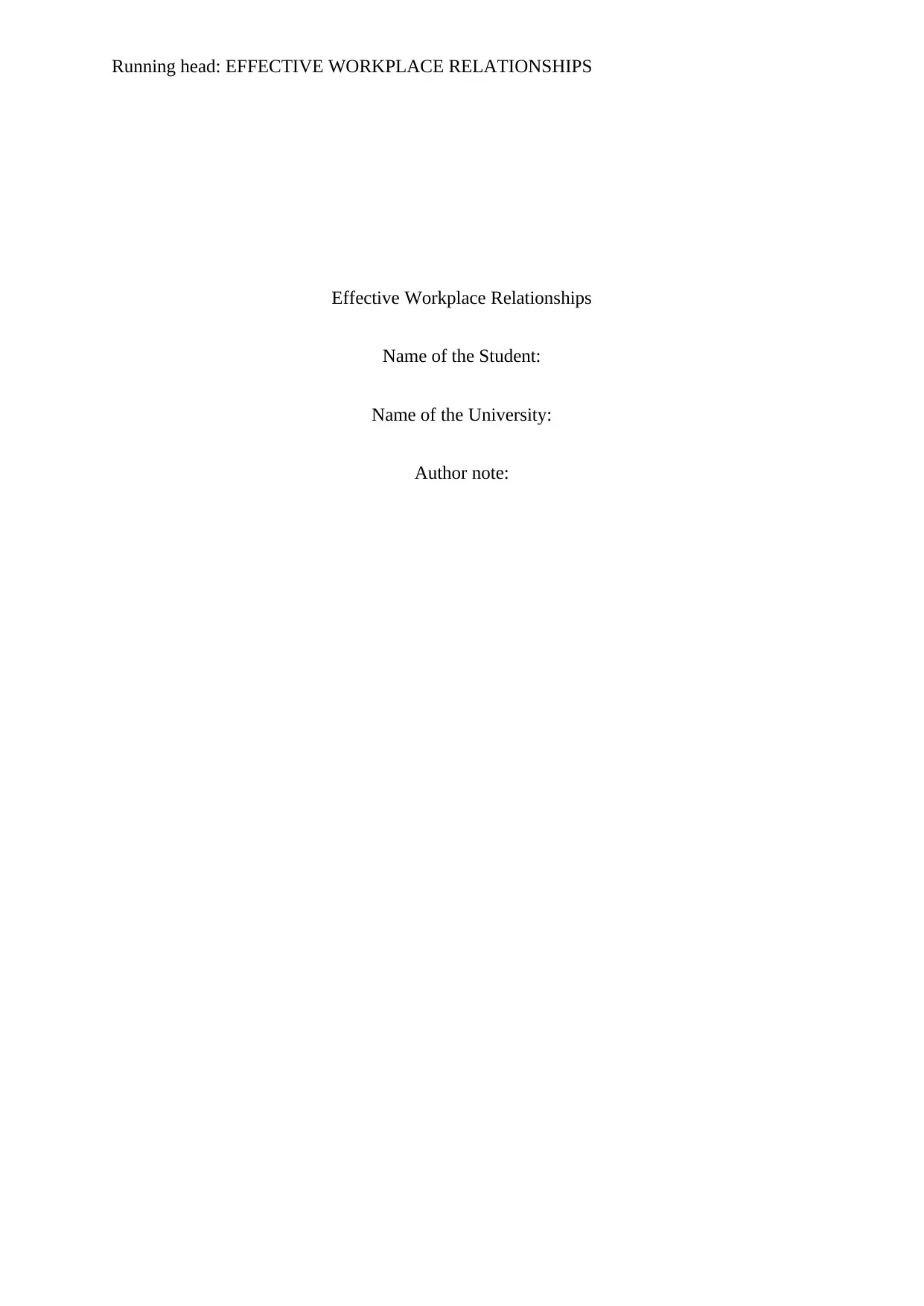
Running head: EFFECTIVE WORKPLACE RELATIONSHIPS
Effective Workplace Relationships
Name of the Student:
Name of the University:
Author note:
Effective Workplace Relationships
Name of the Student:
Name of the University:
Author note:
Paraphrase This Document
Need a fresh take? Get an instant paraphrase of this document with our AI Paraphraser
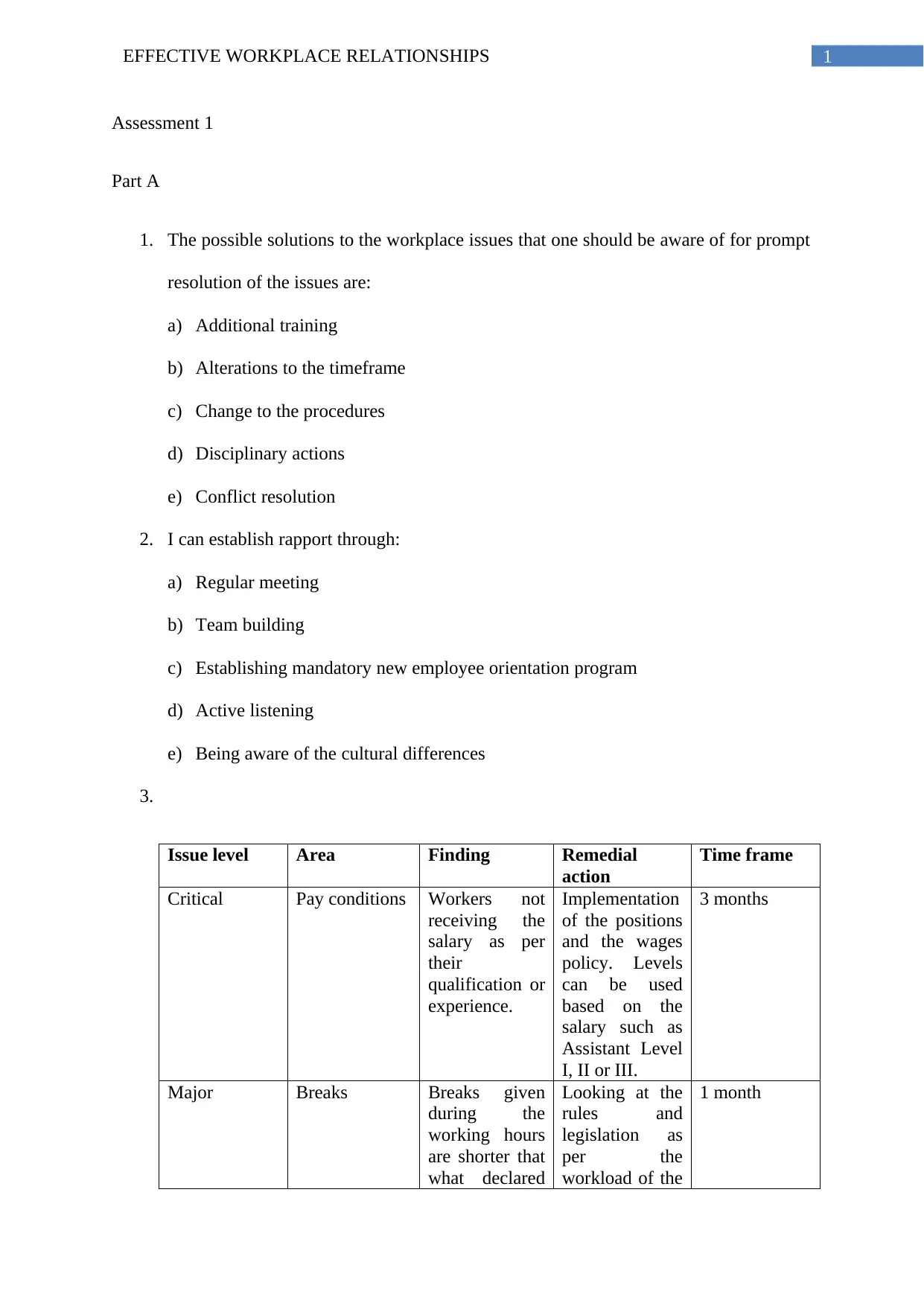
1EFFECTIVE WORKPLACE RELATIONSHIPS
Assessment 1
Part A
1. The possible solutions to the workplace issues that one should be aware of for prompt
resolution of the issues are:
a) Additional training
b) Alterations to the timeframe
c) Change to the procedures
d) Disciplinary actions
e) Conflict resolution
2. I can establish rapport through:
a) Regular meeting
b) Team building
c) Establishing mandatory new employee orientation program
d) Active listening
e) Being aware of the cultural differences
3.
Issue level Area Finding Remedial
action
Time frame
Critical Pay conditions Workers not
receiving the
salary as per
their
qualification or
experience.
Implementation
of the positions
and the wages
policy. Levels
can be used
based on the
salary such as
Assistant Level
I, II or III.
3 months
Major Breaks Breaks given
during the
working hours
are shorter that
what declared
Looking at the
rules and
legislation as
per the
workload of the
1 month
Assessment 1
Part A
1. The possible solutions to the workplace issues that one should be aware of for prompt
resolution of the issues are:
a) Additional training
b) Alterations to the timeframe
c) Change to the procedures
d) Disciplinary actions
e) Conflict resolution
2. I can establish rapport through:
a) Regular meeting
b) Team building
c) Establishing mandatory new employee orientation program
d) Active listening
e) Being aware of the cultural differences
3.
Issue level Area Finding Remedial
action
Time frame
Critical Pay conditions Workers not
receiving the
salary as per
their
qualification or
experience.
Implementation
of the positions
and the wages
policy. Levels
can be used
based on the
salary such as
Assistant Level
I, II or III.
3 months
Major Breaks Breaks given
during the
working hours
are shorter that
what declared
Looking at the
rules and
legislation as
per the
workload of the
1 month
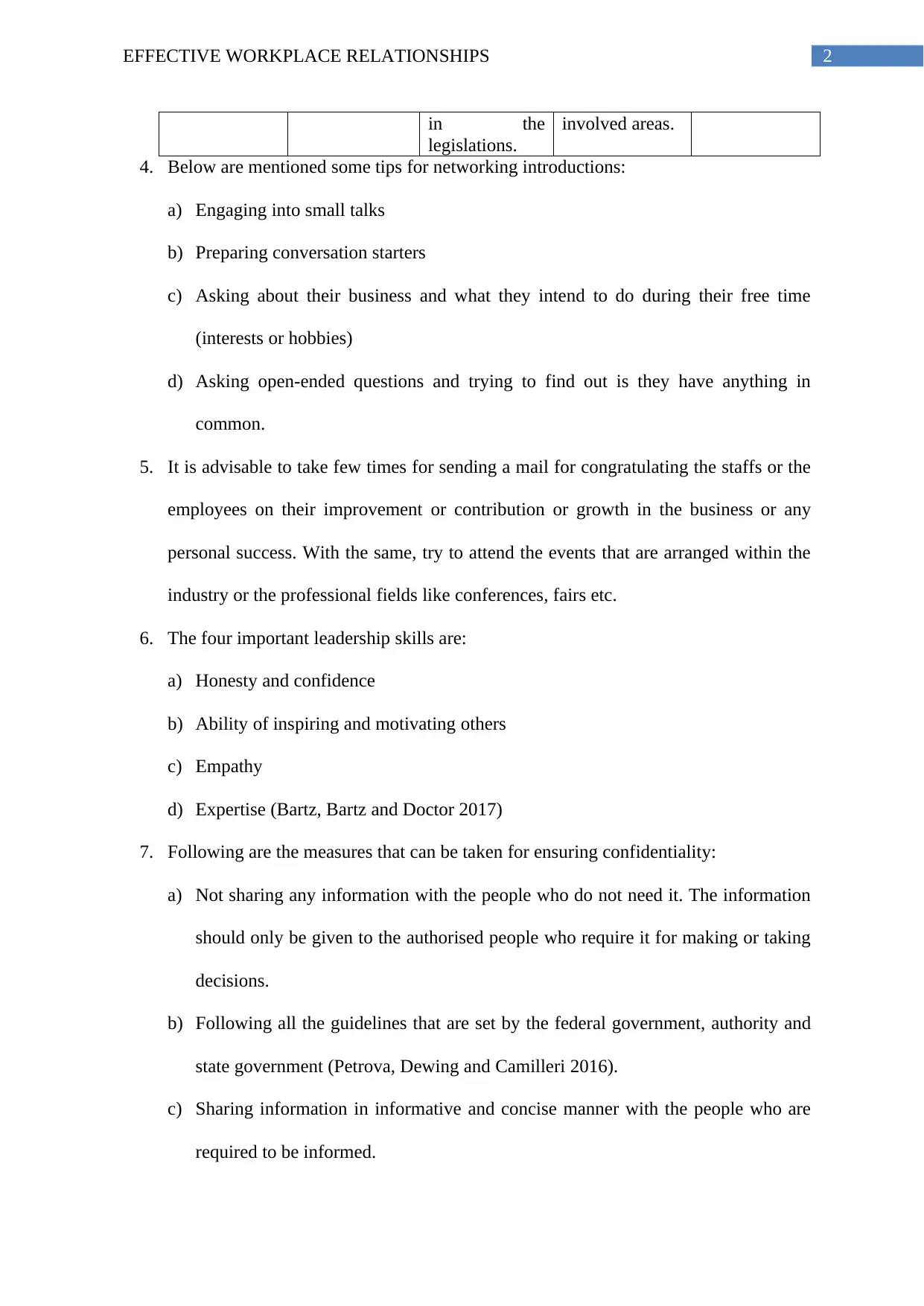
2EFFECTIVE WORKPLACE RELATIONSHIPS
in the
legislations.
involved areas.
4. Below are mentioned some tips for networking introductions:
a) Engaging into small talks
b) Preparing conversation starters
c) Asking about their business and what they intend to do during their free time
(interests or hobbies)
d) Asking open-ended questions and trying to find out is they have anything in
common.
5. It is advisable to take few times for sending a mail for congratulating the staffs or the
employees on their improvement or contribution or growth in the business or any
personal success. With the same, try to attend the events that are arranged within the
industry or the professional fields like conferences, fairs etc.
6. The four important leadership skills are:
a) Honesty and confidence
b) Ability of inspiring and motivating others
c) Empathy
d) Expertise (Bartz, Bartz and Doctor 2017)
7. Following are the measures that can be taken for ensuring confidentiality:
a) Not sharing any information with the people who do not need it. The information
should only be given to the authorised people who require it for making or taking
decisions.
b) Following all the guidelines that are set by the federal government, authority and
state government (Petrova, Dewing and Camilleri 2016).
c) Sharing information in informative and concise manner with the people who are
required to be informed.
in the
legislations.
involved areas.
4. Below are mentioned some tips for networking introductions:
a) Engaging into small talks
b) Preparing conversation starters
c) Asking about their business and what they intend to do during their free time
(interests or hobbies)
d) Asking open-ended questions and trying to find out is they have anything in
common.
5. It is advisable to take few times for sending a mail for congratulating the staffs or the
employees on their improvement or contribution or growth in the business or any
personal success. With the same, try to attend the events that are arranged within the
industry or the professional fields like conferences, fairs etc.
6. The four important leadership skills are:
a) Honesty and confidence
b) Ability of inspiring and motivating others
c) Empathy
d) Expertise (Bartz, Bartz and Doctor 2017)
7. Following are the measures that can be taken for ensuring confidentiality:
a) Not sharing any information with the people who do not need it. The information
should only be given to the authorised people who require it for making or taking
decisions.
b) Following all the guidelines that are set by the federal government, authority and
state government (Petrova, Dewing and Camilleri 2016).
c) Sharing information in informative and concise manner with the people who are
required to be informed.
⊘ This is a preview!⊘
Do you want full access?
Subscribe today to unlock all pages.

Trusted by 1+ million students worldwide
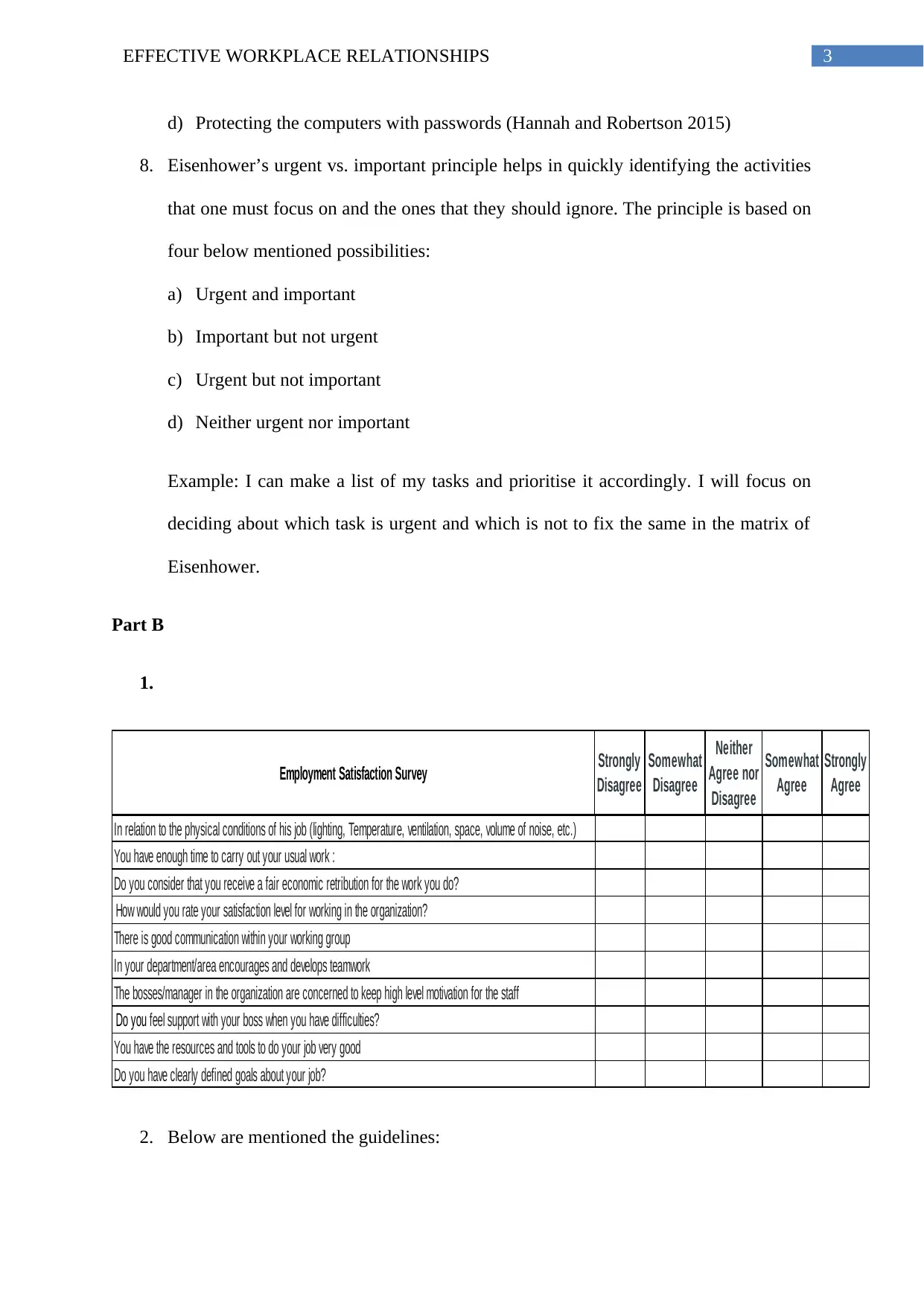
3EFFECTIVE WORKPLACE RELATIONSHIPS
d) Protecting the computers with passwords (Hannah and Robertson 2015)
8. Eisenhower’s urgent vs. important principle helps in quickly identifying the activities
that one must focus on and the ones that they should ignore. The principle is based on
four below mentioned possibilities:
a) Urgent and important
b) Important but not urgent
c) Urgent but not important
d) Neither urgent nor important
Example: I can make a list of my tasks and prioritise it accordingly. I will focus on
deciding about which task is urgent and which is not to fix the same in the matrix of
Eisenhower.
Part B
1.
Employment Satisfaction Survey Strongly
Disagree
Somewhat
Disagree
Neither
Agree nor
Disagree
Somewhat
Agree
Strongly
Agree
In relation to the physical conditions of his job (lighting, Temperature, ventilation, space, volume of noise, etc.)
You have enough time to carry out your usual work :
Do you consider that you receive a fair economic retribution for the work you do?
How would you rate your satisfaction level for working in the organization?
There is good communication within your working group
In your department/area encourages and develops teamwork
The bosses/manager in the organization are concerned to keep high level motivation for the staff
Do you feel support with your boss when you have difficulties?
You have the resources and tools to do your job very good
Do you have clearly defined goals about your job?
2. Below are mentioned the guidelines:
d) Protecting the computers with passwords (Hannah and Robertson 2015)
8. Eisenhower’s urgent vs. important principle helps in quickly identifying the activities
that one must focus on and the ones that they should ignore. The principle is based on
four below mentioned possibilities:
a) Urgent and important
b) Important but not urgent
c) Urgent but not important
d) Neither urgent nor important
Example: I can make a list of my tasks and prioritise it accordingly. I will focus on
deciding about which task is urgent and which is not to fix the same in the matrix of
Eisenhower.
Part B
1.
Employment Satisfaction Survey Strongly
Disagree
Somewhat
Disagree
Neither
Agree nor
Disagree
Somewhat
Agree
Strongly
Agree
In relation to the physical conditions of his job (lighting, Temperature, ventilation, space, volume of noise, etc.)
You have enough time to carry out your usual work :
Do you consider that you receive a fair economic retribution for the work you do?
How would you rate your satisfaction level for working in the organization?
There is good communication within your working group
In your department/area encourages and develops teamwork
The bosses/manager in the organization are concerned to keep high level motivation for the staff
Do you feel support with your boss when you have difficulties?
You have the resources and tools to do your job very good
Do you have clearly defined goals about your job?
2. Below are mentioned the guidelines:
Paraphrase This Document
Need a fresh take? Get an instant paraphrase of this document with our AI Paraphraser
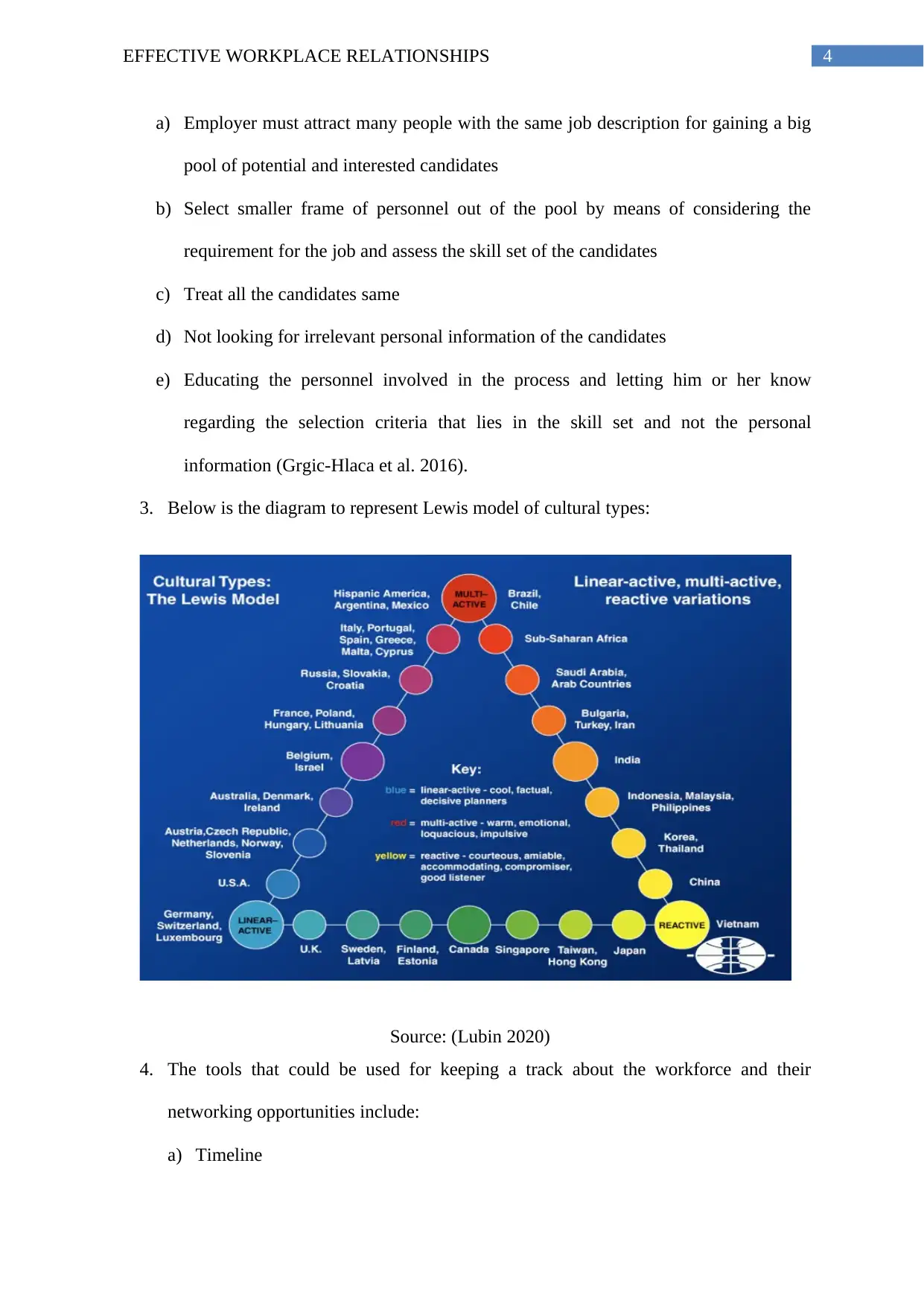
4EFFECTIVE WORKPLACE RELATIONSHIPS
a) Employer must attract many people with the same job description for gaining a big
pool of potential and interested candidates
b) Select smaller frame of personnel out of the pool by means of considering the
requirement for the job and assess the skill set of the candidates
c) Treat all the candidates same
d) Not looking for irrelevant personal information of the candidates
e) Educating the personnel involved in the process and letting him or her know
regarding the selection criteria that lies in the skill set and not the personal
information (Grgic-Hlaca et al. 2016).
3. Below is the diagram to represent Lewis model of cultural types:
Source: (Lubin 2020)
4. The tools that could be used for keeping a track about the workforce and their
networking opportunities include:
a) Timeline
a) Employer must attract many people with the same job description for gaining a big
pool of potential and interested candidates
b) Select smaller frame of personnel out of the pool by means of considering the
requirement for the job and assess the skill set of the candidates
c) Treat all the candidates same
d) Not looking for irrelevant personal information of the candidates
e) Educating the personnel involved in the process and letting him or her know
regarding the selection criteria that lies in the skill set and not the personal
information (Grgic-Hlaca et al. 2016).
3. Below is the diagram to represent Lewis model of cultural types:
Source: (Lubin 2020)
4. The tools that could be used for keeping a track about the workforce and their
networking opportunities include:
a) Timeline
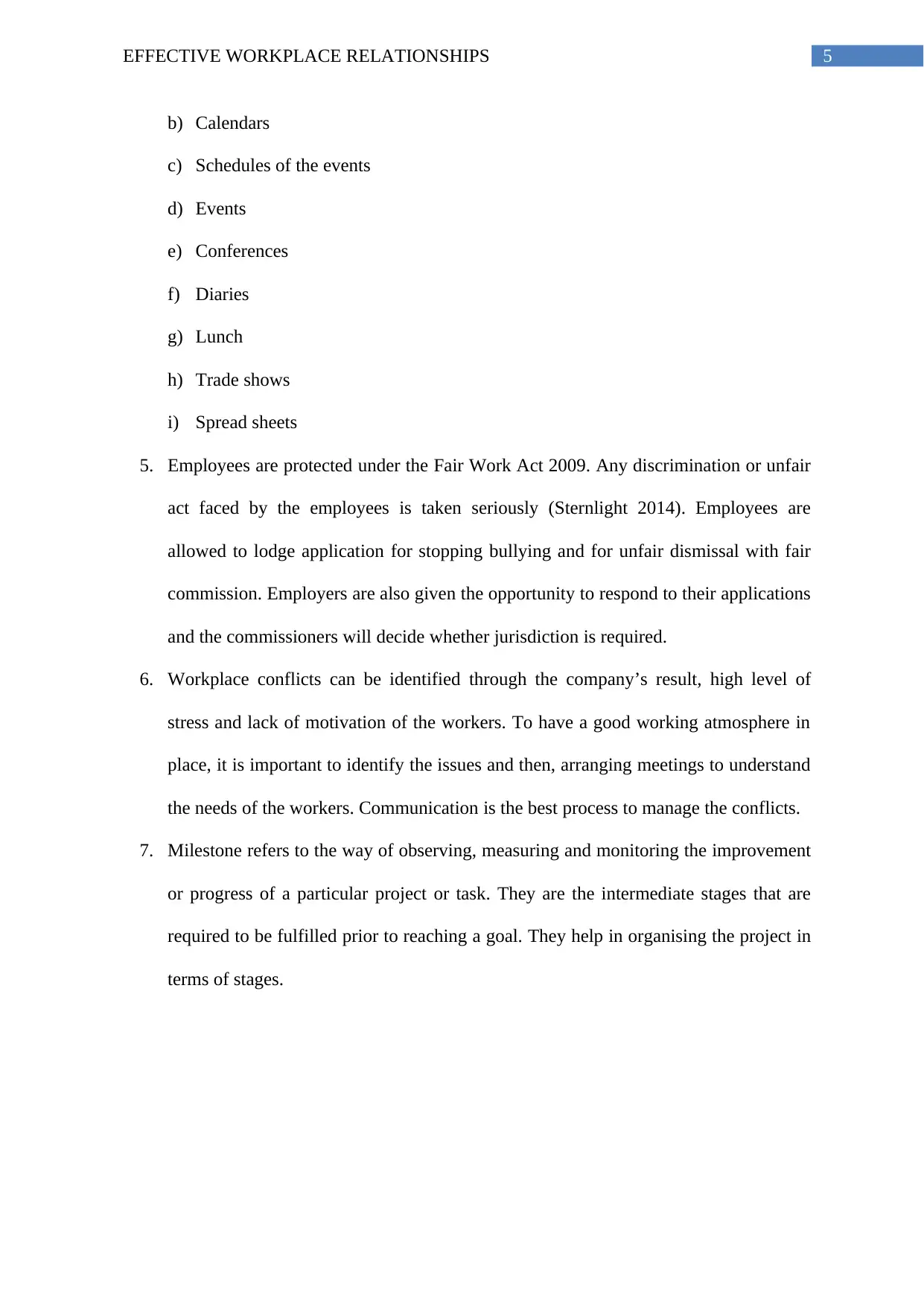
5EFFECTIVE WORKPLACE RELATIONSHIPS
b) Calendars
c) Schedules of the events
d) Events
e) Conferences
f) Diaries
g) Lunch
h) Trade shows
i) Spread sheets
5. Employees are protected under the Fair Work Act 2009. Any discrimination or unfair
act faced by the employees is taken seriously (Sternlight 2014). Employees are
allowed to lodge application for stopping bullying and for unfair dismissal with fair
commission. Employers are also given the opportunity to respond to their applications
and the commissioners will decide whether jurisdiction is required.
6. Workplace conflicts can be identified through the company’s result, high level of
stress and lack of motivation of the workers. To have a good working atmosphere in
place, it is important to identify the issues and then, arranging meetings to understand
the needs of the workers. Communication is the best process to manage the conflicts.
7. Milestone refers to the way of observing, measuring and monitoring the improvement
or progress of a particular project or task. They are the intermediate stages that are
required to be fulfilled prior to reaching a goal. They help in organising the project in
terms of stages.
b) Calendars
c) Schedules of the events
d) Events
e) Conferences
f) Diaries
g) Lunch
h) Trade shows
i) Spread sheets
5. Employees are protected under the Fair Work Act 2009. Any discrimination or unfair
act faced by the employees is taken seriously (Sternlight 2014). Employees are
allowed to lodge application for stopping bullying and for unfair dismissal with fair
commission. Employers are also given the opportunity to respond to their applications
and the commissioners will decide whether jurisdiction is required.
6. Workplace conflicts can be identified through the company’s result, high level of
stress and lack of motivation of the workers. To have a good working atmosphere in
place, it is important to identify the issues and then, arranging meetings to understand
the needs of the workers. Communication is the best process to manage the conflicts.
7. Milestone refers to the way of observing, measuring and monitoring the improvement
or progress of a particular project or task. They are the intermediate stages that are
required to be fulfilled prior to reaching a goal. They help in organising the project in
terms of stages.
⊘ This is a preview!⊘
Do you want full access?
Subscribe today to unlock all pages.

Trusted by 1+ million students worldwide
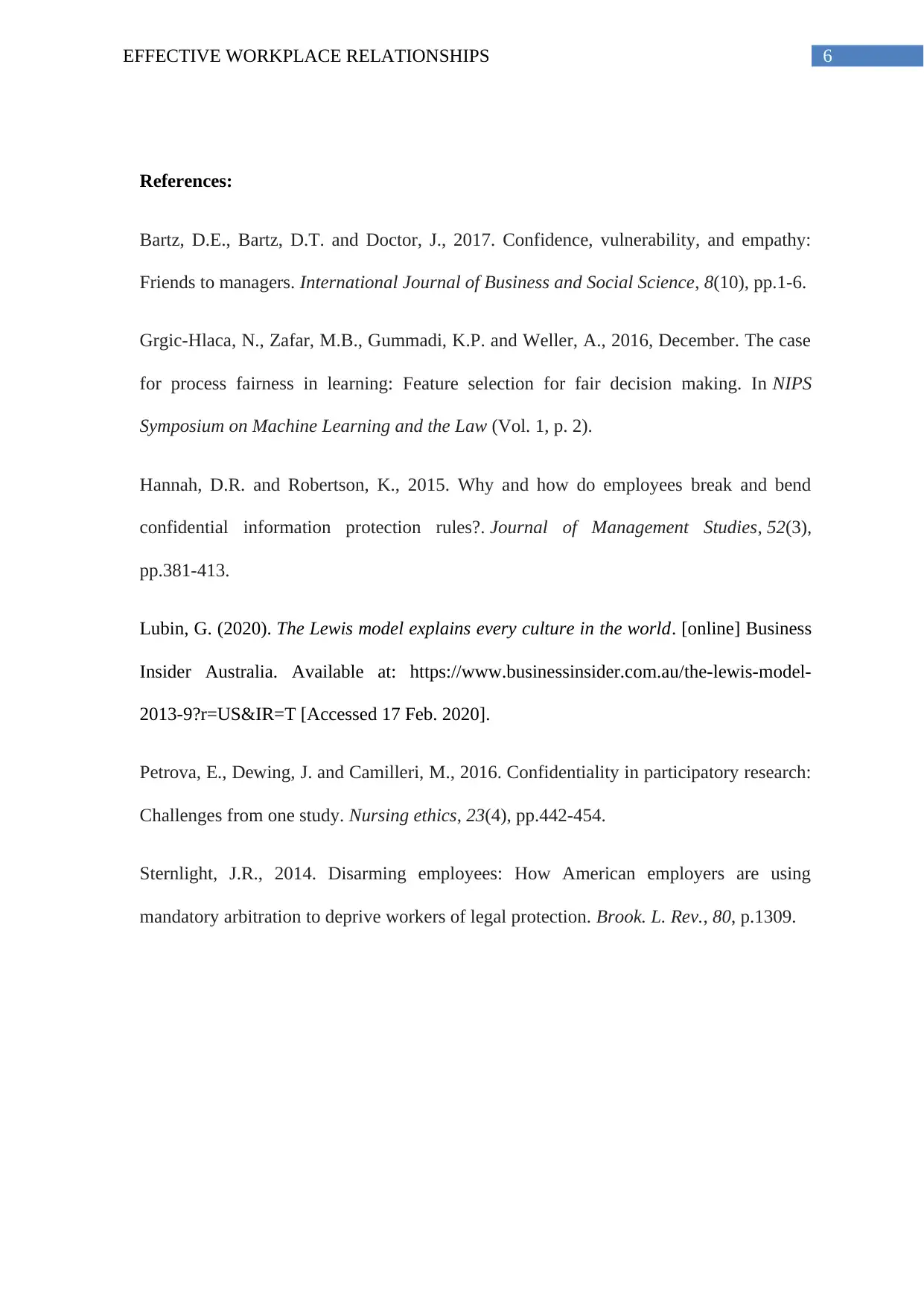
6EFFECTIVE WORKPLACE RELATIONSHIPS
References:
Bartz, D.E., Bartz, D.T. and Doctor, J., 2017. Confidence, vulnerability, and empathy:
Friends to managers. International Journal of Business and Social Science, 8(10), pp.1-6.
Grgic-Hlaca, N., Zafar, M.B., Gummadi, K.P. and Weller, A., 2016, December. The case
for process fairness in learning: Feature selection for fair decision making. In NIPS
Symposium on Machine Learning and the Law (Vol. 1, p. 2).
Hannah, D.R. and Robertson, K., 2015. Why and how do employees break and bend
confidential information protection rules?. Journal of Management Studies, 52(3),
pp.381-413.
Lubin, G. (2020). The Lewis model explains every culture in the world. [online] Business
Insider Australia. Available at: https://www.businessinsider.com.au/the-lewis-model-
2013-9?r=US&IR=T [Accessed 17 Feb. 2020].
Petrova, E., Dewing, J. and Camilleri, M., 2016. Confidentiality in participatory research:
Challenges from one study. Nursing ethics, 23(4), pp.442-454.
Sternlight, J.R., 2014. Disarming employees: How American employers are using
mandatory arbitration to deprive workers of legal protection. Brook. L. Rev., 80, p.1309.
References:
Bartz, D.E., Bartz, D.T. and Doctor, J., 2017. Confidence, vulnerability, and empathy:
Friends to managers. International Journal of Business and Social Science, 8(10), pp.1-6.
Grgic-Hlaca, N., Zafar, M.B., Gummadi, K.P. and Weller, A., 2016, December. The case
for process fairness in learning: Feature selection for fair decision making. In NIPS
Symposium on Machine Learning and the Law (Vol. 1, p. 2).
Hannah, D.R. and Robertson, K., 2015. Why and how do employees break and bend
confidential information protection rules?. Journal of Management Studies, 52(3),
pp.381-413.
Lubin, G. (2020). The Lewis model explains every culture in the world. [online] Business
Insider Australia. Available at: https://www.businessinsider.com.au/the-lewis-model-
2013-9?r=US&IR=T [Accessed 17 Feb. 2020].
Petrova, E., Dewing, J. and Camilleri, M., 2016. Confidentiality in participatory research:
Challenges from one study. Nursing ethics, 23(4), pp.442-454.
Sternlight, J.R., 2014. Disarming employees: How American employers are using
mandatory arbitration to deprive workers of legal protection. Brook. L. Rev., 80, p.1309.
1 out of 7
Your All-in-One AI-Powered Toolkit for Academic Success.
+13062052269
info@desklib.com
Available 24*7 on WhatsApp / Email
![[object Object]](/_next/static/media/star-bottom.7253800d.svg)
Unlock your academic potential
Copyright © 2020–2025 A2Z Services. All Rights Reserved. Developed and managed by ZUCOL.

